
Buenos Aires is one of those cities that, simply mentioned, immediately makes you travel. Argentina's capital, with its 3 million inhabitants - the Porteños - is brimming with all kinds of riches. Every year, it attracts tourists from the four corners of the globe. The capital of the world's eighth-largest country attracts visitors with its museums, its customs and, of course, its passion for soccer. But Buenos Aires goes even further, surprising the curious traveller with its scents, tango steps, parks, historic squares and brightly-coloured houses. Buenos Aires is, in a way, the first essential stopover before setting off to discover the rest of Argentina.
1. What to do in Buenos Aires Visit the Bosques de Palermo
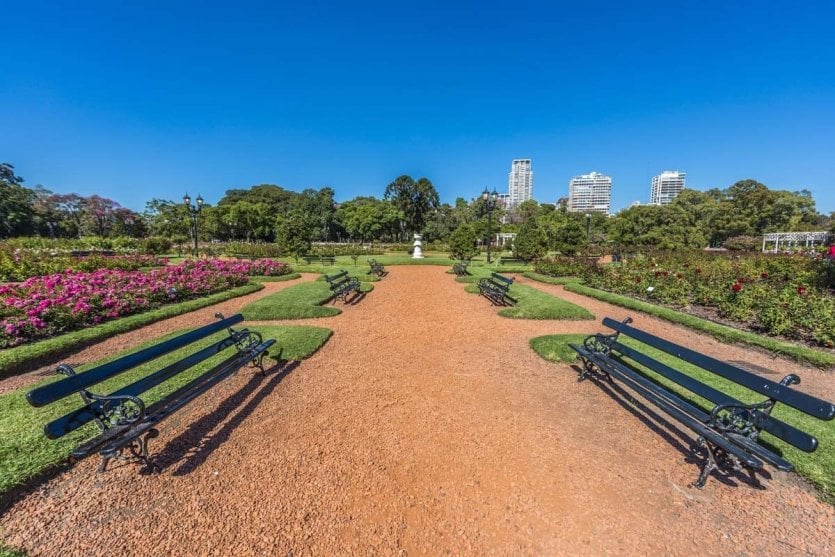
They are to Buenos Aires what Central Park is to New York. Real name Parque Tres de Febrero, the Bosques de Palermo cover 25 hectares. Inaugurated in 1875, the landscape architects were inspired by the Bois de Boulogne in Paris and the Prater in Vienna. Its many riches make it the most important green space in Argentina's capital. Inside, visitors will find some 15 plazas (squares), 4 artificial lakes with their own activities, the Botanical Garden and the Galileo Galilei Planetarium. It also boasts one of the city's most beautiful spots: El Rosedal. Added to the park in 1916, it now boasts over 18,000 rosebushes, including several hundred varieties. It's a mix of French and English parkland, with Hispanic culture sprinkled throughout. A popular weekend destination, the Bosques de Parlermo offers a relaxing break from the hustle and bustle of Buenos Aires.
2. La Boca district and Caminito Street

This is one of Buenos Aires' most famous neighborhoods. Even before you enter, the word "futbol" is on everyone's lips. This is where you'll find the Boca Junior stadium, also known as La Bombonera, one of the city's most emblematic stadiums. Maradona used to play here. A true working-class district, La Boca has always been inhabited by the most working-class classes in Buenos Aires. In the 20th century, La Boca was occupied by immigrants. Today, there are still many of them, mainly Bolivians and Paraguayans. A must: Caminito Street and its brightly painted houses. There are also many street painters who have set up their studios on the street. An open-air museum.
We recommend you book a guided tour of the district here: you'll discover the birthplace of tango and its bohemian, artistic and multicultural history.
3. What to do in Buenos Aires Visit the Colón Theatre
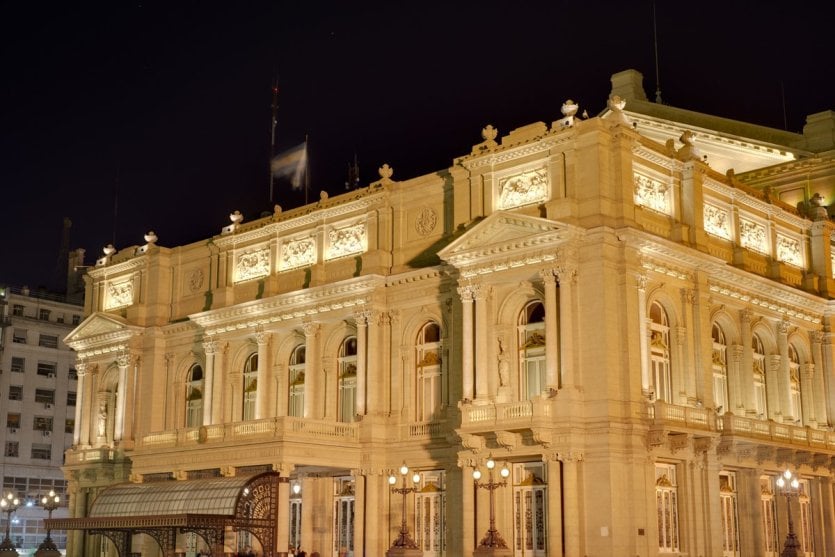
Its history and acoustics make the Teatro Colón one of the best in the world. Inaugurated on May 25, 1908, with Verdi's Aida as its first performance, it is now the most prestigious opera house in the world. Built by architects Fransisco Tamburini, Vittorio Meano and Jules Dorma, the opera house's influences are manifold. The former was inspired by the neo-baroque of the Opéra Garnier in Paris, the others by Italian neo-Renaissance and Art Nouveau. The auditorium is huge, with a capacity of 2,487. The dome above it was repainted by Raoul Soldi in 1966. Today, the theater is open to the public. The tour takes visitors behind the scenes of the opera, where they can see the costumes and sets. The Orquesta Filarmonica de Buenos Aires, for example, performs under its roof.
4. Buenos Aires Museum of Latin American Art

Located in the Palermo district, the Buenos Aires Museum of Latin American Art (MALBA) can be spotted from afar. Its eccentric architecture makes this museum a must-see in the capital. Designed by Córdoba architects Atelman, Fourcade and Tapia, the museum is characterized by its juxtaposition of irregular cubic volumes. Its large bay windows on the facade give the building plenty of light. MALBA was originally designed to house the collection of Eduardo F. Costantini. The museum opened to the public in September 2001. Today, MALBA attracts visitors as much for its exterior as for its cultural treasures. It boasts one of the city's richest collections, with over 400 works of art. The museum features numerous artistic creations from the 20th century to the present day, including works by Frida Khalo.
5. What to do in Buenos Aires Visit the Recoleta cemetery
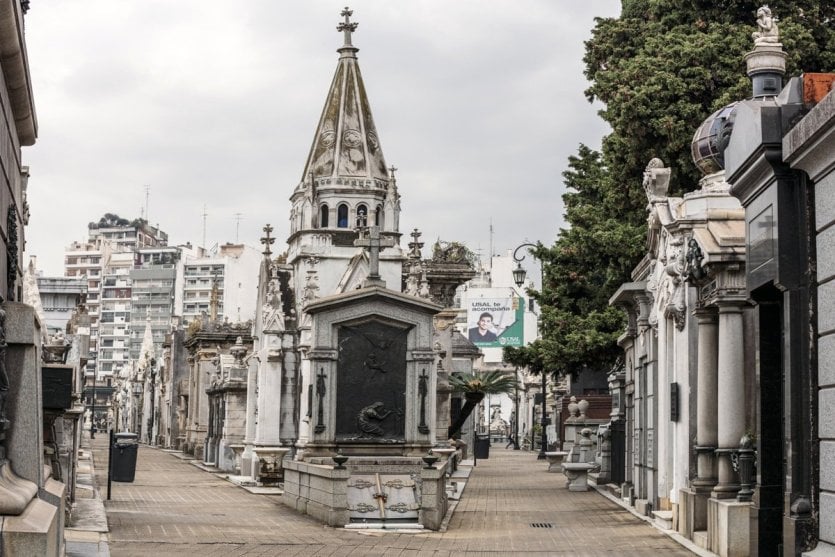
Founded in 1822, the "Père-Lachaise porteño " is in itself a veritable open-air museum, covering more than 6 hectares. It's interesting to stroll among the tombs of famous Argentinian figures, including Evita Perón (Duarte family), but the cemetery's narrowness and lack of greenery make for a rather sad atmosphere. Nevertheless, it's easy to spend hours observing the details of the statues and marble mausoleums, or trying to identify the mortuary of one or other of Argentina's illustrious elite. The magnificent portico at the entrance, known for its sober Greek architectural style, speaks volumes about the prestige accorded to the site. The Recoleta cemetery, set apart from the capital's historic districts like San Telmo, is one of the true witnesses to the city's history and development, thanks to the works of art that have accumulated there since 1822.
6. The Bombonera stadium

Find out all about Boca's true passion: soccer. A visit to the Bombonera stadium (La Bonbonnière), videos recounting the history of the Boca club, computers displaying statistical data, a mural of Maradona, a 360° cinema... a unique way to discover one of the most famous soccer stadiums, the Bombonera. Not to be confused with its neighbor, the Monumental, home to River Plate, their ancient rivals. You might offend more than one Argentinian, for soccer is a cult in Argentina.
If you'd like to watch a soccer match live in Buenos Aires and immerse yourself in the excitement of match day, we recommend you pre-book your tickets right here!
7. Tortori café

Quite simply: Buenos Aires' legendary café. Founded in 1858, it's the oldest café in the country. It's impossible to leave the city without at least one cup of coffee... Time has stood still here. Take the opportunity to explore the premises, including the wooden literary salon (at the back). The café also houses a tourist information point for the municipality of Buenos Aires. Tango shows are regularly performed in the basement, in a very intimate atmosphere. A must-see!
8. Plaza de Mayo
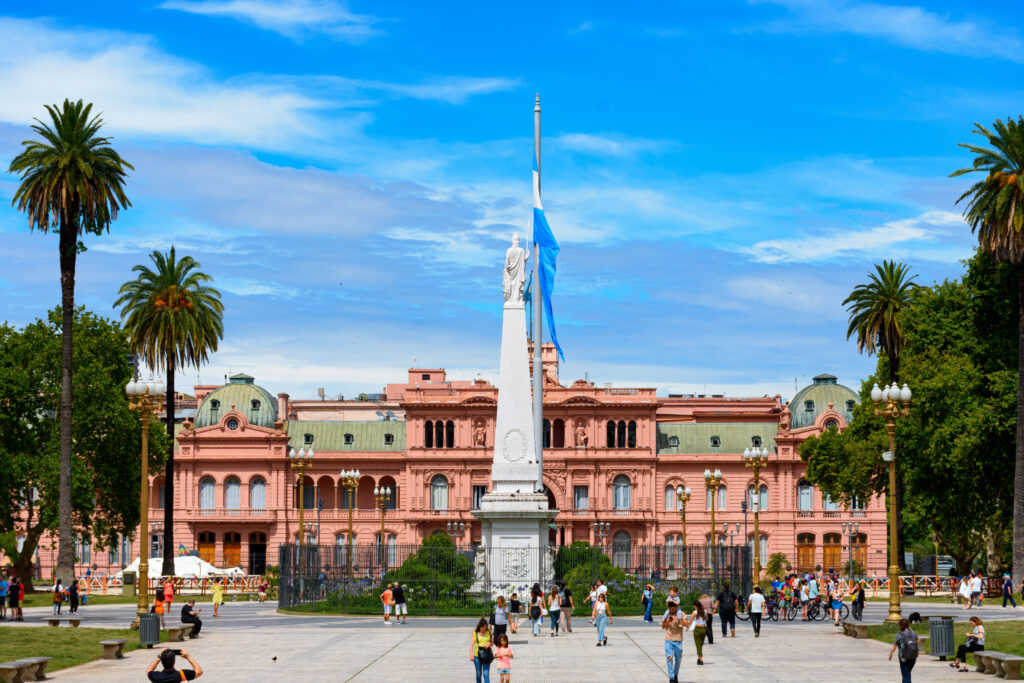
The vast Plaza de Mayo is the historic and political heart of the city of Buenos Aires. Today's plaza includes the original Plaza Mayor (or Plaza Grande), laid out by the conquistador Juan de Garay when he founded the city of Buenos Aires on June 11, 1580, and is surrounded by the city's and the country's main centers of power: the Casa Rosada, seat of the Presidency of the Nation, the Metropolitan Cathedral, the Cabildo (former municipality), theBuenos Aires City Government Palaceand the headquarters of the Banco de la Nación Argentina. From the square, the beautiful Avenida de Mayo leads to the Congreso de la Nación, Argentina's parliament building, after crossing the impressive Avenida 9 de Julio. The Plaza de Mayo is the nerve center of the people's expression. All the political and social demonstrations and protests that shake the capital leave from or arrive here.
We recommend that you book this 3-hour guided tour, which takes in the main sights of Buenos Aires. You'll start at the Plaza de Mayo, where your guide will tell you all about its history and introduce you to its most important buildings and monuments.
9. What to do in Buenos Aires See the Casa Rosada

Statue of General Belgrano in front of the Casa Rosada © Meunierd
It's a bit like Argentina's White House, except that it's pink... In 1580, Juan de Garay chose this spot to build the fort of Buenos Aires. Gradually abandoned, the citadel was replaced by a building that is now the seat of executive power. Legend has it that its pink color is the result of a compromise devised by President Sarmiento (1873): the two political forces of the time had white (the Unitarians) and red (the Federalists) as their symbols. A regiment of grenadiers guards the residence. The regiment is relieved every day at around 7 a.m. A key monument on the Plaza de Mayo. Just behind the Casa Rosada, the Museo del Bicentenario was inaugurated by President Cristina Kirchner in May 2011.
10. Buenos Aires Metropolitan Cathedral
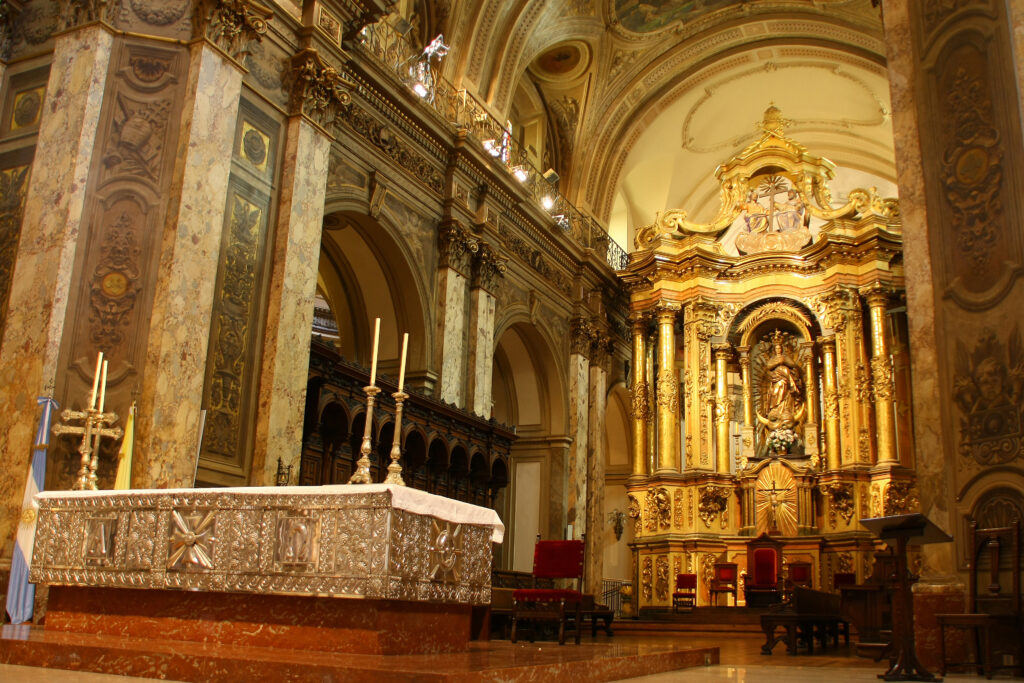
Built between 1753 and 1827, the cathedral is a blend of neoclassical and baroque architecture, with Greek and Roman elements. As you enter the building, you'll have the opportunity to admire several treasures, such as the Baroque altar dating from the late 18th century, a Christ carved from carob wood, frescoes by Italian artist Pablo Parisi, and the Capilla del Santísimo Sacramento adorned with marble and bronze. And don't miss the mausoleum of General San Martín, draped in the Argentine flag. He died in exile in the French town of Boulogne-sur-Mer, and his remains were repatriated to Argentina. In his honor, an eternal flame shines on the right-hand side of the façade.
11. What to do in Buenos Aires Visit the San Telmo district and its feria
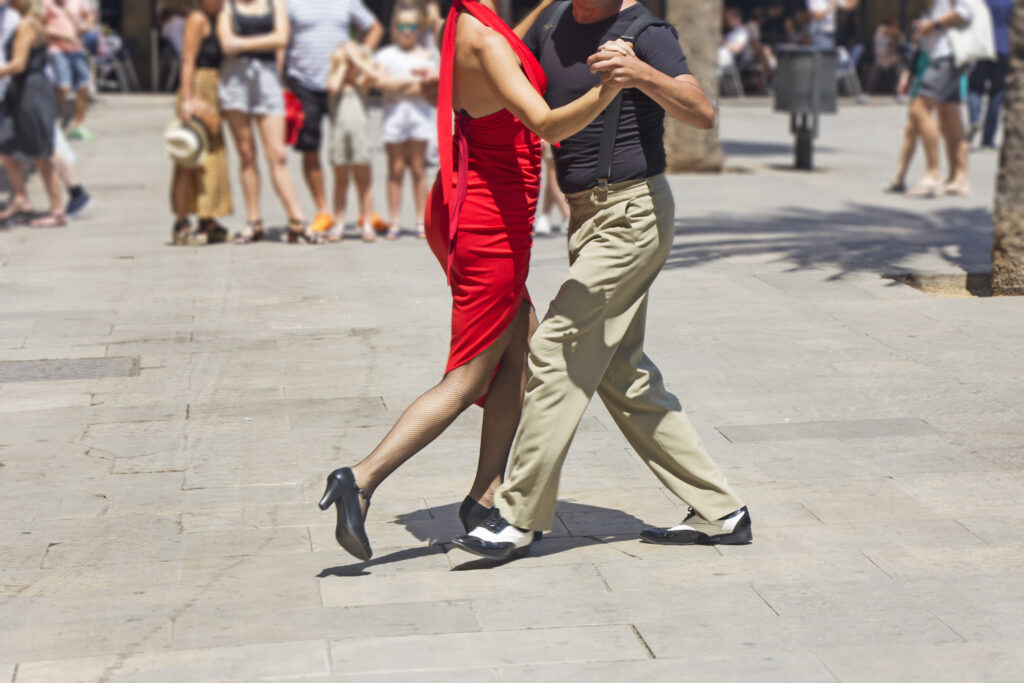
Once upon a time, San Telmo was the main district of Buenos Aires, and Plaza Dorrego its center. Today, it's a must-see for tourists looking for a taste of Buenos Aires. Not to be missed: the Feria de San Telmo. A Sunday visit is a must to see the streets of San Telmo bustling with tango dancers. Tourists can enjoy the neighborhood and the street entertainment. Tango dancers are joined by concerts and artists. Slipping into the general hustle and bustle means discovering typical cafés and a multitude of trinkets in boutiques. The entire Plaza Dorrego is taken up by craft and antique stalls. The Feria de San Telmo attracts over 10,000 visitors every Sunday.
12. Admire the street art of Buenos Aires
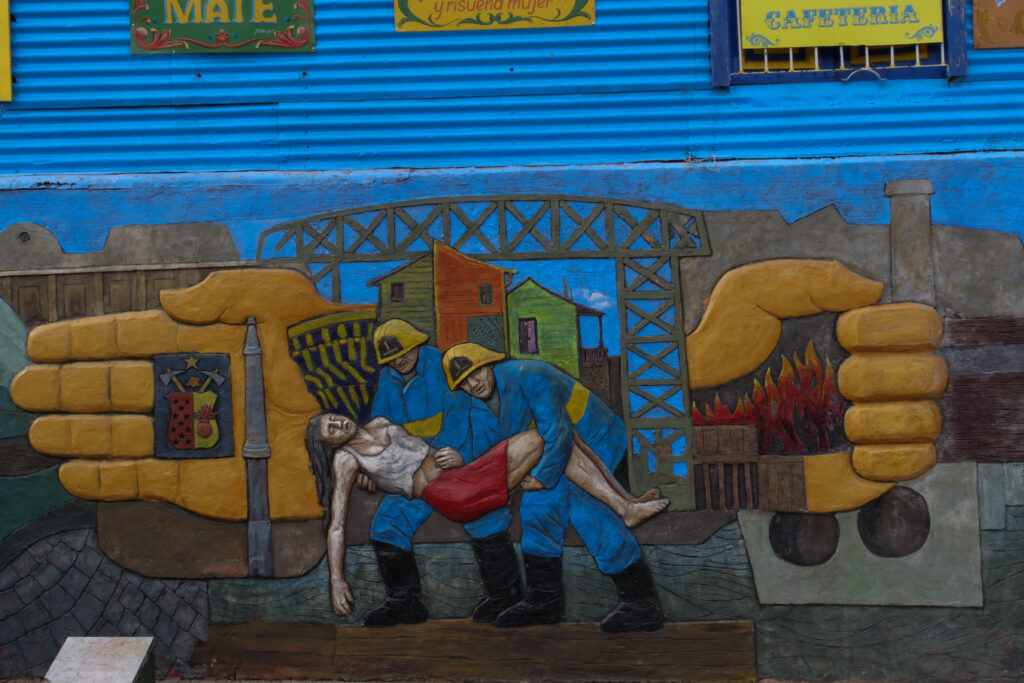
Buenos Aires is a city renowned for its street art. As you stroll through the different neighborhoods, you'll have the opportunity toadmire true masterpieces created by local and international artists. We recommend Palermo, Colegiales and Villa Urquiza. The Palermo Soho area in particular is a veritable open-air museum, where you can admire works of art in a variety of styles, from realism to abstract to surreal. Don't miss a stroll through the streets of Colegiales, where the murals are particularly impressive for their size and artistic quality. Last but not least, Villa Urquiza is a residential neighborhood that has seen the emergence of many works of street art in recent years.
We recommend taking part in this guided street art tour of Buenos Aires, which will help you explore the Palermo district and discover the creative work of numerous artists and designers.
13. What to do in Buenos Aires Visit the Fundación Proa

Located in the La Boca district, a stone's throw from the famous Caminito, the Fundación Proa is a must-see on the Buenos Aires cultural scene. Inaugurated in 1996, this non-profit foundation is dedicated to the promotion of contemporary art and art education. It houses several exhibition spaces featuring works by local and international artists, as well as a library specializing in contemporary art and a cinema. Temporary exhibitions, often accompanied by lectures, workshops and screenings, provide an opportunity to discover emerging and world-renowned artists, as well as major artistic movements.
14. Walking around the Reserva Ecológica
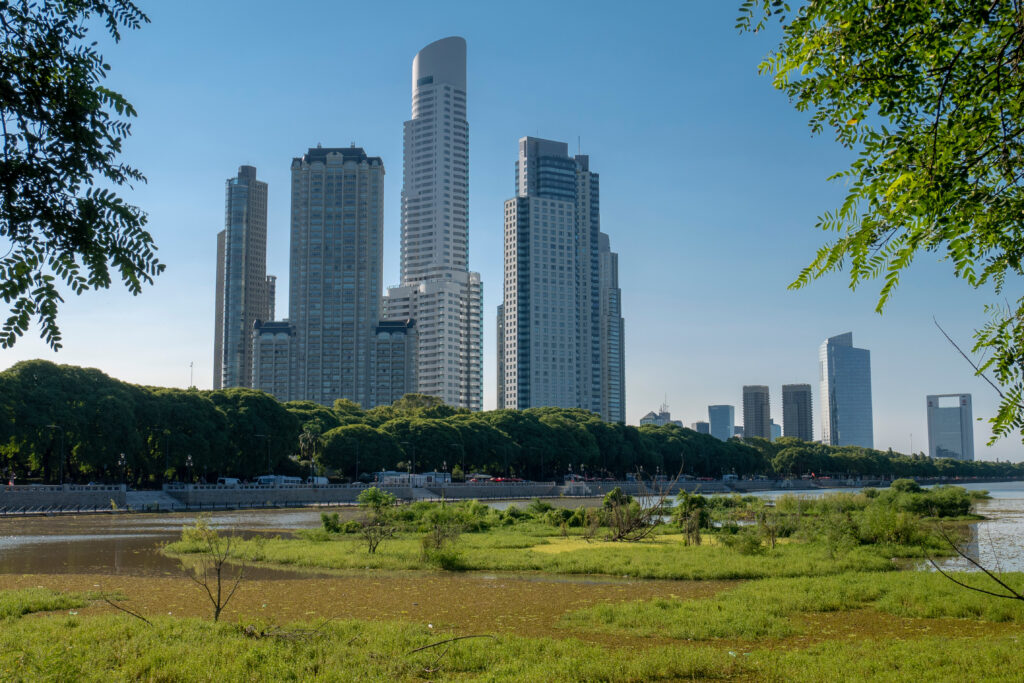
The Reserva Ecológica in Buenos Aires is the fruit of an ambitious rehabilitation project. Two itineraries are available: circuito 1, which is 3.3 km long and takes 2 hours to complete, starts opposite Calle Brasil. Circuito 2, on the other hand, starts opposite Viamonte street and runs for 2.2 km, lasting around 1 hour. This reserve is a pleasant escape from the hustle and bustle of the city, offering the chance to picnic by the delta. The views of the skyscrapers, which stand out behind a green natural area, promise surprising and memorable photographs.
15. What to do in Buenos Aires Take in a tango show at a landmark venue
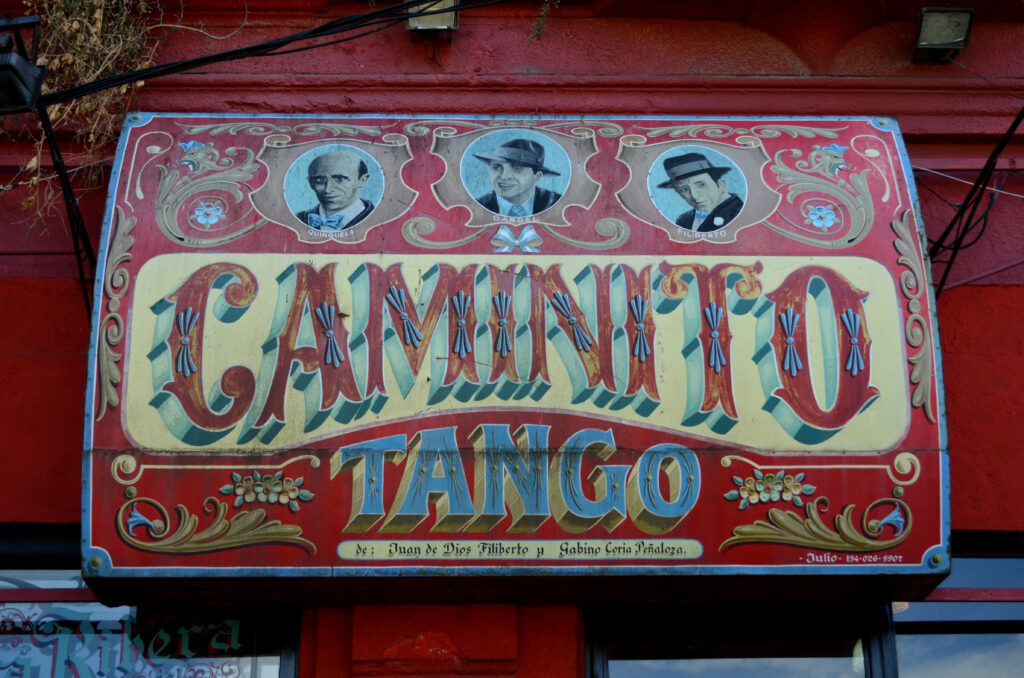
Buenos Aires, the capital of Argentina, is renowned as the birthplace of tango, the sensual, passionate dance that has conquered the world. Among the must-visit addresses, Café Tortoni, the oldest café in Buenos Aires, will immerse you in an authentic atmosphere steeped in history. Rojo Tango, located in the elegant Faena Hotel, offers intimate and refined performances. Looking for an unforgettable evening? We recommend booking this tango show at Mansión Tango, one of Buenos Aires' most emblematic buildings.
We also recommend a visit to one of the milongas, dance halls where locals gather to dance the tango: among the most famous are La Catedral, El Beso and La Viruta.
16. Taste Argentine wines
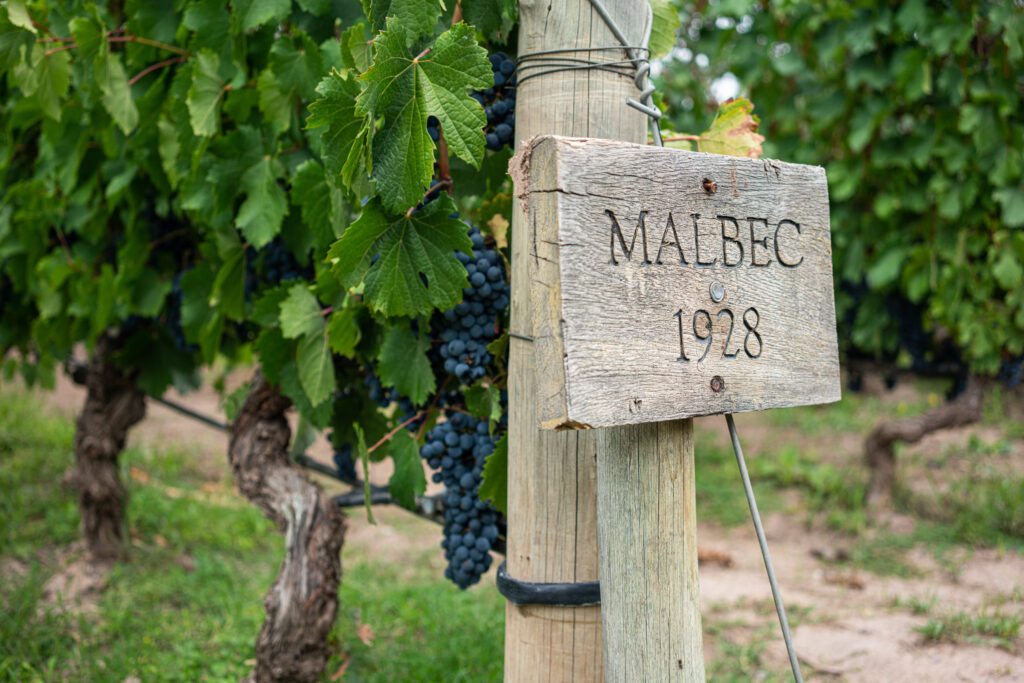
Buenos Aires is renowned for its vineyards and exceptional grape varieties, particularly Malbec, which has seduced palates the world over. We recommend a visit to one of the city's many wine bars, where you can sample vintages from different Argentine wine-growing regions. The Gran Bar Danzón, located in the Palermo district, is one of the must-visit addresses, offering an impressive and varied wine list, accompanied by delicious dishes to share. Le Pain et Vin, in the Recoleta district, is also a great place to enjoy Argentinian wines in a warm and friendly atmosphere.
For a more immersive experience, why not take part in a guided wine tasting by booking here ? You'll learn more about Argentine grape varieties, terroirs and winemaking techniques, while tasting quality wines. Finally, if you have more time, consider an excursion to the Mendoza region, the cradle of Malbec, where you can visit vineyards and meet passionate producers.
17. Taste Argentina's culinary specialties
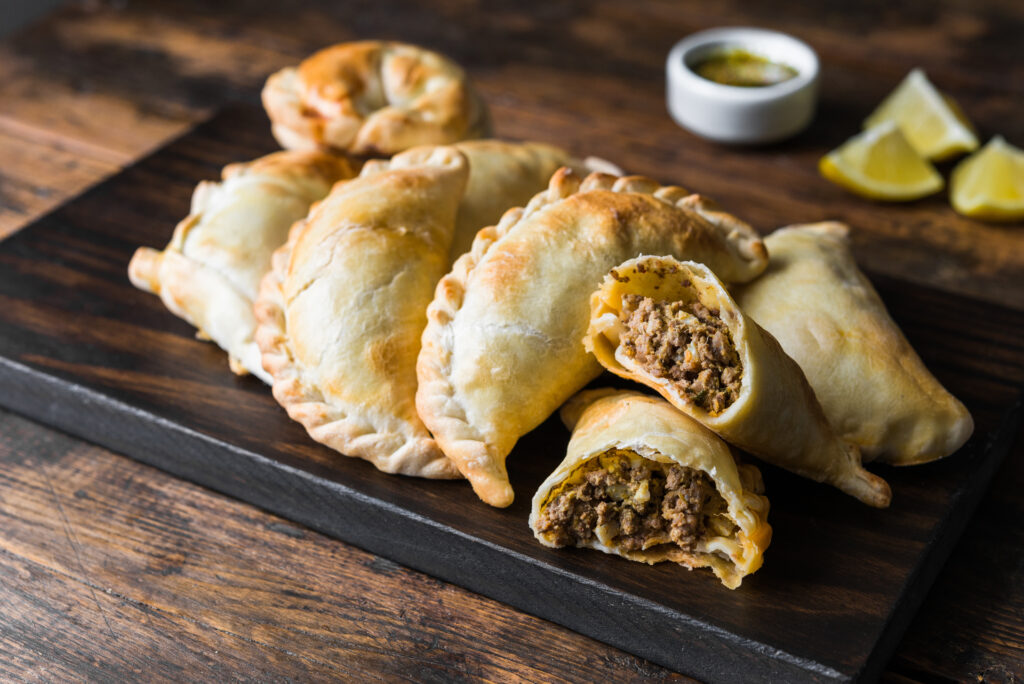
Buenos Aires is one of the best places to discover Latin American gastronomy. Among the must-tries are traditional parillas, succulent grilled meats prepared using ancestral methods. Empanadas, or turnovers stuffed with meat, cheese or vegetables, are another Argentinian specialty not to be missed. On the sweet side, alfajores are one of the world's most gourmet desserts. These delicious cookies are filled with dulce de leche, a milk jam, or fruit, and coated with a chocolate or coconut glaze. To discover Argentina's culinary specialties, we recommend visiting local markets such as the Mercado de San Telmo or the Mercado de Belgrano or booking this 9-course Argentinian meat tasting at Fogón Asado the chef will explain the different cuts of meat you'll taste on the menu, as well as cooking techniques and a brief history of the Asado tradition.
Where to stay in Buenos Aires?
Buenos Aires, the capital of Argentina, is a vibrant and dynamic city with many different neighborhoods, each with its own personality and attractions. Palermo is one of Buenos Aires' trendiest neighborhoods, known for its cobblestone streets, parks, designer boutiques and trendy restaurants. It is divided into several sub-neighborhoods, including Palermo Soho and Palermo Hollywood. Recoleta is an elegant and sophisticated neighborhood, known for its historic cemetery, museums, art galleries and French-style buildings. It's also home to numerous luxury hotels and upscale restaurants. San Telmo is Buenos Aires' oldest district, known for its cobbled streets, colonial buildings, flea markets and open-air tango shows. It has a relaxed, bohemian atmosphere.
Here are our 3 favorite accommodations in Buenos Aires:
- The cheapest: Ayres de San Telmo
This hostel is housed in a handsome, well-maintained three-storey building dating from the 1930s. There's a fully equipped kitchen and a terrace for barbecuing. It's a practical, comfortable address for those on a budget, and you can book it right here.
- Best located: the Grand King Hotel
The Grand King Hotel is a 4-star hotel located on a lively shopping street in Buenos Aires, which you can book right here. It boasts an ideal location, close to the city's main attractions. The Art Deco-style Teatro Gran Rex is just a 6-minute walk away, while the majestic Teatro Colón and Casa Rosada palace can be reached in less than 15 minutes on foot. It is also well served by public transport and easily accessible by car.
- The one with the exceptional breakfast: Icaro Suites
Located in downtown Buenos Aires, the Ícaro Suites is a 4-star hotel offering comfortable, relaxed accommodation close to numerous sights, restaurants and bars. The breakfast, included in the room rate, is exceptional (cold cuts, cheese, eggs and bacon, cereals, pastries, fruit...) The hotel also offers a gym, sauna and parking at an additional cost. Click here to to book your stay!
What to see in Buenos Aires in two days
Buenos Aires, the capital of Argentina, is a city rich in culture, history and entertainment. If you've only got two days to explore this vibrant city, here are a few suggestions to help you make the most of your stay.
Day 1:
Morning
- Start your day at the Plaza de Mayo. Take time to admire the Casa Rosada and the Metropolitan Cathedral.
- Then head for San Telmo, about a 15-minute walk away. Stroll the cobbled streets and explore the flea market (if it's a Sunday).
Afternoon
- Take a cab or bus to La Boca (approx. 15-20 minutes). Visit Caminito and enjoy tango shows in the street.
- Return to your hotel to rest and prepare for the evening.
Evening
- Attend a tango show at an iconic venue such as El Viejo Almacén or Rojo Tango. Book in advance to ensure you have a seat.
Day 2 :
Morning
- Start your day in Recoleta. Visit the Recoleta cemetery and Evita Perón's tomb. Then stroll through Parque Thays.
- Head for the Teatro Colón (about 20 minutes on foot or 10 minutes by cab). Book a guided tour of the theater to learn more about its history and architecture.
Afternoon
- Take a cab or bus to Palermo (approx. 10-15 minutes). Explore the stores, restaurants and bars of Palermo Soho and Palermo Hollywood.
- Relax in the Bosques de Palermo and enjoy the green spaces and lakes.
Evening
- Round off your day with a visit to MALBA (Museo de Arte Latinoamericano de Buenos Aires), open until 9pm on Wednesdays and 8pm on other days. Enjoy Latin American art before finding a local restaurant for dinner.
This itinerary is flexible and can be adapted to suit your preferences and the time you have available. Don't forget to take into account the opening times of attractions and book in advance when necessary.
Tempted by a vacation in Argentina? Here are our three tips
- Book in advance below the trendiest activities to do during a stay in Buenos Aires in December, for example:
- Take a look at our airfares and book now !


